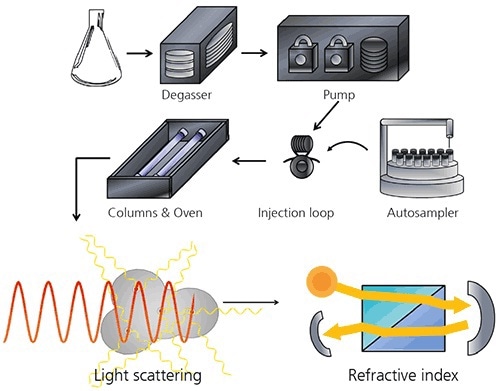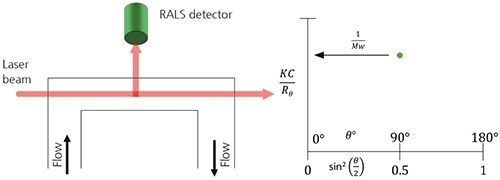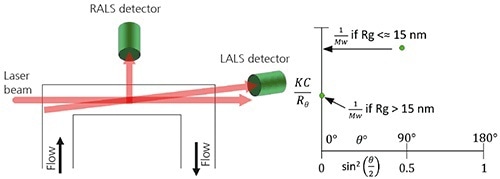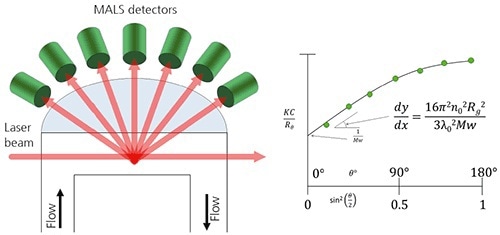Classical light scattering or static light scattering is a technique utilized to determine gyration’s molecular radius and molecular weight.
In static light scattering, a range of different techniques exist with acronyms, such as RALS, LALS, SLS, MALS, etc. Each technique is slightly different and offers a number of advantages and disadvantages. In this article, the theories and principles behind static light scattering are described in detail.
Molecular Weight and Molecular Size
Molecular weight is defined as the molar mass of the molecule being examined. The distributions of molecular weights can be explained in several ways, but one common method is to utilize the molecular weight moments such as Mz, Mw and Mn which stands for z-averaged, weight- averaged and number-averaged molecular weights, respectively. Using these three values, a better understanding of the entire distribution of molecular weights can be obtained.
Molecular size refers to the molecule’s physical size. Generally, a single value is utilized to describe the size, and this value refers to the radius of a sphere of an equal size to the molecule under measurement. Radius of gyration (Rg) and hydrodynamic radius (RH) are the two commonly used values of molecular size. Rg also called as Rrms, is measured by means of static light scattering.
Static Light Scattering
When a particle or molecule is bombarded with light, some part of the light is absorbed and reproduced in all directions. The principle behind light scattering can be utilized to determine several properties with respect to the molecule.
Static light scattering (SLS) is a technique that utilizes an optical arrangement in such a way that the signal detected is stable or static. The sample’s molecular weight can be calculated by determining the intensity of light dispersed by a sample in conditions where other constants are known. SLS measurements can be performed in a size-exclusion chromatography system (SEC) or in a gel-permeation chromatography (GPC) (Figure 1).

Figure 1. Schematic of a GPC/SEC system. The degasser, pump, injection loop and columns are standard with the optional autosampler. After separation, the molecules are measured by one or more detectors in sequence.
A chromatography system eliminates the complications associated with preparation and purifications of sample. SEC or GPC also helps in integrating the light scattering data with the data obtained from a concentration detector to determine the concentration of the sample simultaneously. A refractive index detector (R) is commonly used, but an ultraviolet (UV) absorbance detector can also be employed.
Light Scattering Instruments
Four types of SLS instruments are available, namely RALS, LALS, MALS and Hybrid RALS/LALS. These instruments are described in the following paragraphs.
Right-Angle Light Scattering (RALS) Detectors
A RALS instrument is the simplest among all the light scattering devices. It has the ability to determine the intensity of the light dispersed at 90° to the incident beam (Figure 2A). The sample’s molecular weight is then measured from the sample concentration and the intensity measured. In the Zimm plot (Figure 2A), the intensity of the scattered light is calculated far from the y-axis and the sample is believed to be isotropic. The simplest form of SLS detector, the RALS detector can be developed sans any complicated optics.

Figure 2. A. Schematic of a RALS detector showing the flow passing through the flow cell. B. When using RALS, the Debye plot is reduced to a single point which is assumed to be equal at every angle and therefore equal 1/Mw.
The advantages of the RALS system are as follows:
- Simplest form of SLS detector
- Measures molecular weight precisely for molecules with Rg < ≈15 nm
- Has the smallest flow cells
- Excellent sensitivity and signal-to-noise ratio
- Any noise or flare produced by the change in refractive index is reduced
- Suitable for measuring protein molecular weight
However, a RALS device cannot precisely determine the molecular weight of molecules with an Rg > ≈15 nm. It can measure only at 90°.
Low-Angle Light Scattering (LALS) Detectors
A LALS detector is capable of measuring the intensity of light dispersed at an angle close to 0° (Figure 3A). In this technique, the intensity will be near to the intensity at 0° and hence the estimated molecular weight will be close to the exact molecular weight of the molecule.

Figure 3. A. Schematic of a LALS detector showing the flow passing through the flow cell. B. When using LALS, the Debye plot is reduced to a single point which is close to the y-axis and therefore equal 1/Mw for all molecules.
The advantages of the LALS technique are as follows;
- LALS determines the intensity of scattered light close to the axis of the Zimm plot and hence the estimated molecular weight has the highest precision
- Have low volume flow cells
- Determines the molecular weight of molecules with a high level of precision
- Measures at the lowest angle possible
However, the LALS detector cannot be used to determine Rg as the scattered light is only being quantified at a single angle. Unlike RALS detectors, LALS detector is less susceptible to weakly scattering samples.
RALS/LALS Hybrid Detectors
A RALS/LALS hybrid detector integrates RALS and LALS detectors into a single unit (Figure 4A). On the Zimm plot, the RALS instrument is employed to determine molecules whose size is less than the ≈15 nm upper limit of isotropic scattering.

Figure 4. A. Schematic of a RALS/LALS hybrid detector showing the flow passing via the flow cell. B. When using RALS/LALS, the Debye plot is reduced to two points where the RALS value is used to maximize sensitivity for isotropic scatterers.
The advantages of the RALS/LALS hybrid detectors are:
- Combines LALS and RALS devices into a single unit
- Uses RALS to improve sensitivity for weak scatterers
- Uses LALS to improve the precision for anistropic scatterers
- Excellent sensitivity for both smaller and larger molecules
- Maintains the small flow cells of LALS and RALS detectors
- Allows Rg to be measured
However, RALS/LALS hybrid detectors also have certain limitations. In case the SEC or GPC system is unclean, the LALS data can prove to be noisy. Also, the calculation of Rg has a limited precision.
Multi-angle Light Scattering (MALS) Detectors
MALS detectors are capable of measuring the intensity of the light disperse at many angles (Figure 5A). When these points are plotted on a Zimm plot (Figure 7B), it is possible to extrapolate a suitable fit line back to 0° and from here the molecular weight can be determined. The starting slope of this line allows for a precise calculation of Rg.

Figure 5. A. Schematic of a MALS detector showing the flow passing through the flow cell. B. When using MALS, the Debye plot is completed and extrapolated back to 0°.
The advantages of the MALS instruments are as follows:
- Measures the intensity of scattered light scattered at various angles and extrapolates back to 0°
- Measures the molecular weight of molecules of all sizes
- Measurements at multiple angles increases confidence in the results
- Angles can be removed, if needed
- Measures the Rg of molecules > ≈15 nm
MALS instruments also have some disadvantages. Since the actual structure and shape of the molecule are not known, it is hard to determine which extrapolation model and fit will give the right answer. In addition, optical complexity also increases the cost.
Among all the techniques, LALS instruments allow precise measurement of molecular weight of large molecules as it has a tendency to reduce the influence of the angular dependence of the dispersed light and also removes the necessity for extrapolation.
MALS determines the molecular weight across the entire size range and provides a better understanding about the angular dependence of the dispersed light for large molecules greater than 10 to 15 nm radius, allowing high quality and precise measurement of Rg.
Instrument Calibration
Some form of calibration is required for all light scattering instruments and this can be performed in two ways: Molecular weight standard-based calibration and scattering standard-based calibration. The former method calibrates all light scattering detectors simultaneously and enables calibration constants, peak broadening corrections and inter-detector volumes of other detectors to be quantified at the same time. The latter method can only calibrate the 90° detector and other detectors have to be normalized by using a subsequent step with another standard. Peak broadening, inter-detector volumes and tailing calculations should be carried out separately.

This information has been sourced, reviewed and adapted from materials provided by Malvern Panalytical.
For more information on this source, please visit Malvern Panalytical.